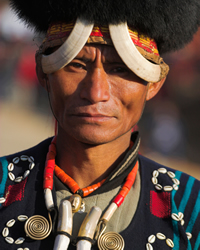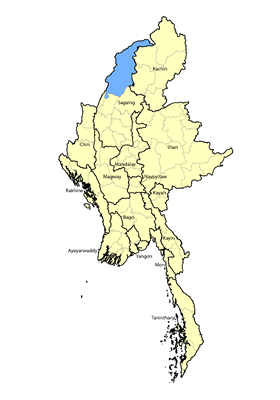This profile represents another distinct Tangshang tribe that has never before appeared on any list of the world's people groups. Political considerations have influenced the Tangshang on both sides of the border. Naga insurgent groups want the tribes to identify as Nagas and join their cause, while local officials, under pressure from politicians, often combine small tribes and unrelated language groups, as the larger the population, the more political power and influence a community has.
Location: The Haqsik tribe, numbering approximately 1,600 people, live in Pangsau, which is part of Lahe Township in western Myanmar's Sagaing Region. The largest community of Haqsik people is found in the village of Woktham, with over 100 households, many of which have ten or more people living under the same roof. An estimated 1,200 Haqsik people live across the border in India, where they are also known as the Laju.
Language: After a research team visited Pangsau in 2012 and surveyed 660 Haqsik people, the data and wordlists they compiled caused considerable surprise when it emerged that the Haqsik language was unlike any other Tangshang variety in Myanmar and was therefore not grouped together with any other language or dialect group. Until new research is conducted, Haqsik remains a stand-alone language among approximately 70 Tangshang varieties in Myanmar and India.
The incredible ethnolinguistic diversity among the Tangshang has resulted in 50 different tribes being profiled in Operation Myanmar, with a further 15 smaller groups not being fully profiled due to a lack of available information regarding their populations and locations. The Haqsik appear to be one of the tribes that formerly engaged in the very dark practice of human sacrifice, which the British stamped down by heavily punishing those involved. The grisly act was mixed with layers of subterfuge, as victims were carefully chosen by slave owners and treated like members of the family, rendering them oblivious to the fate that awaited them.
Thankfully, the human sacrifice employed by the Haqsik in the 19th century has ended. A historian detailed that sordid practice: “When purchased for sacrifice, the victim is kept in the house of the owner, well cared for and fed but kept in stocks if there is any suspicion that escape may be attempted. The sacrifice is within a month of purchase unless bought for resale. On the appointed day, selected by divination by ‘wise' men, the victim is drugged with opium or drink, or failing these, even beaten into insensibility, led to the front verandah of the house, and decapitated by a blow on the neck from behind. The skull, when clean, is divided in two and the front is hung in the room…. The body is divided up and the bones, flesh, and entrails are sold as charms.”
Until the first families in Pangsau began to convert to Christianity in the 1950s, all Tangshang people there were animists. Their fear of the spirit world was so ingrained that “no undertaking could be implemented without obtaining permission from and placating the relevant spirits. They had to be always attended to, even to setting some food aside for them at certain meals. Due to their omnipresence and their habit of moving around, no fixed temple or abode was erected for the spirits.”
Because the mountains of western Myanmar and northeast India are some of the least visited inhabited places on earth, many Christians remain unaware that one of the greatest revivals in Christian history took place there during the 20th century. Millions of people from over 100 distinct tribes surrendered to the living God as the fire of the Holy Spirit blazed across the region, transforming entire communities in west and north Myanmar, Nagaland, Manipur, Mizoram, and other states of India. The Haqsik were one tribe caught up in this mass movement to Christ. Today, practically all Haqsik people are Christians, with most worshiping in Baptist churches.
Scripture Prayers for the Haqsik in Myanmar (Burma).
| Profile Source: Asia Harvest |











